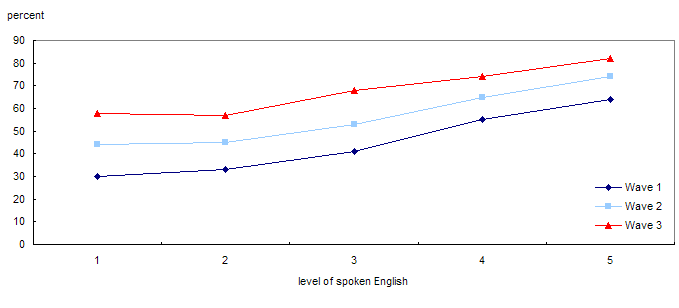Common menu bar links
2005
Archived Content
Information identified as archived is provided for reference, research or recordkeeping purposes. It is not subject to the Government of Canada Web Standards and has not been altered or updated since it was archived. Please "contact us" to request a format other than those available.
Section 3: Labour market
The LSIC collects information on all jobs held by new immigrants since their arrival in Canada. However, this study focuses more specifically on the job that immigrants held at the time of each interview. 1 When an immigrant held more than one job at the time of the interview, only data on the main job 2 were used.
Important note on employment rates in the LSIC
The LSIC provides a good measure of employment rates because the start and end dates of each job spell were collected. However, it is not possible to obtain unemployment and labour force participation rates. Because respondents were not asked if they were looking for a job during every jobless spell, the LSIC does not differentiate between unemployment and out of the labour force status. For this reason, only employment rates are examined.
Usually, an employment rate refers to a specific period in time, e.g., an employment rate for a given month. In the case of the LSIC, the reference period used does not fall within the same calendar period for all respondents. For example, the Wave 1 employment rate corresponds to the number of immigrants who held a job six months after their arrival in Canada. More specifically, for immigrants who came to Canada between October 2000 and September 2001, the employment rate is an average rate covering the months of April 2001 to March 2002.
Employment rate by age group 3
The percentage of immigrants employed grew substantially over time. The employment rate of immigrants aged 25 to 44 (the prime working-age group) went from 51% six months after arrival to 65% two years after arrival, reaching 75% four years after arrival. The employment rate of immigrants in Wave 3 thus approaches the national rate for Canadians in the same age group calculated for the equivalent period, 4 namely 81.8%.
The employment rate of immigrants aged 45 and over is much lower at each wave than that of immigrants in the prime working-age group, while that of immigrants aged 15 to 24 is between the two, as may be seen in chart 3.1 . The chart for each province are provided in appendix E .
When immigrants’ employment status at the time of each interview is examined, 5 it emerges that just over one-third of immigrants were employed at all three points in time. Slightly more than one-quarter (27%) of immigrants were employed at two of the three times, while approximately one-fifth (18%) were employed at only one time in the three. Table 3.1 shows more specifically the waves in which immigrants were working. In general, where immigrants were working in a given wave, they tended also to be working in subsequent waves.
Among immigrants aged 25 to 44, 39% were employed at all three times, while 29% were employed at two times out of three, and 17% were employed at only one time out of three.

| Number of immigrants | Percentage | |
|---|---|---|
| Were not employed at the three waves | 34,000 | 22 |
| Employed only at one wave out of three | ||
| Employed at wave 1 only | 4,300 | 3 |
| Employed at wave 2 only | 5,800 | 4 |
| Employed at wave 3 only | 18,000 | 11 |
| Employed at 2 out of 3 waves | ||
| Employed at waves 1 and 2 | 5,900 | 4 |
| Employed at waves 1 and 3 | 8,300 | 5 |
| Employed at waves 2 and 3 | 28,200 | 18 |
| Employed at all 3 waves | 53,200 | 34 |
| Total | 157,600 | 100 |
Job changes
Immigrants who come to Canada are sometimes in a hurry to find a first job in order to meet their needs and those of their family, but they will not necessarily stay at this job throughout their first four years in Canada. Indeed, two-thirds of immigrants who had worked since their arrival had held two or more jobs, while 34% had held three or more jobs since their arrival in Canada. Sixteen percent of immigrants did not report working since their arrival.
Four years after coming to Canada, immigrants who had held at least one job had worked an average of 146 weeks, or over two-thirds of the period. The average number of weeks worked by immigrants aged 15 to 24 was 123, while the average number of weeks worked by those aged 25 to 44 and those aged 45 and over were similar, at 152 and 147 weeks respectively.
Time it took to obtain first job
Chart 3.2 gives an idea of the time that it took (in number of weeks) to obtain the first job for immigrants in the prime working-age group of 25 to 44 years, by immigration category.
The number of weeks that it took to obtain a first job by immigrants aged 25 to 44 differs by immigration category. A large proportion of principal applicants in the skilled worker category found a first job quickly, and by the time four years had passed, more than 96% had found their first job.
Family class immigrants also found a first job fairly quickly, but 15% did not work during their first four years.
Starting at approximately the twentieth week, two categories—spouses and dependents of skilled workers and other economic immigrants (Other)—exhibit fairly similar patterns with respect to the number of weeks taken to obtain a first job. For both these immigration categories, the proportion of immigrants who had not worked at any time since their arrival is similar to that of immigrants in the family reunification category.
Refugees obtained a first job less quickly, but starting at approximately the twentieth week, they saw their employment rate rise steadily over time, reaching 78% after four years in Canada.
Results by province are provided in appendix F .
Employment rate of 25-to-44-year-olds and OLs
A knowledge of the OLs can be expected to be an asset in looking for a job. Setting aside the employment rates of immigrants aged 25 to 44 who do not speak English at all and immigrants who speak it poorly, which are not significantly different (levels 1 and 2), we observe that the employment rate increases with the self-reported level of proficiency in spoken English, for each of the three waves (see chart 3.3 ).
In Quebec, the employment rate increases with the level of spoken English. However, this effect appears to diminish over time, since in Wave 3, the employment rates of the five levels of spoken English are not significantly different from one another.
The results for French in Quebec are less consistent. The employment rate of immigrants who speak French fairly well (level 3) is lower than that of all other levels. However at Wave 3, if French level 3 is excluded, the appearance of the curves for English and French is similar, although the difference between levels 4 and 5 is larger for French than for English.
Even so, at all waves, immigrants who speak French very well have a higher employment rate than immigrants who speak it less well (see charts 3.4 and 3.5 ).

It should be kept in mind that these charts do not take into account other variables that may affect employment rates. The next section examines the effect of knowledge of official languages on whether one has an appropriate job, using regression models. These models control simultaneously for the effect of several important characteristics, such as immigration category, sex, age group, etc.





